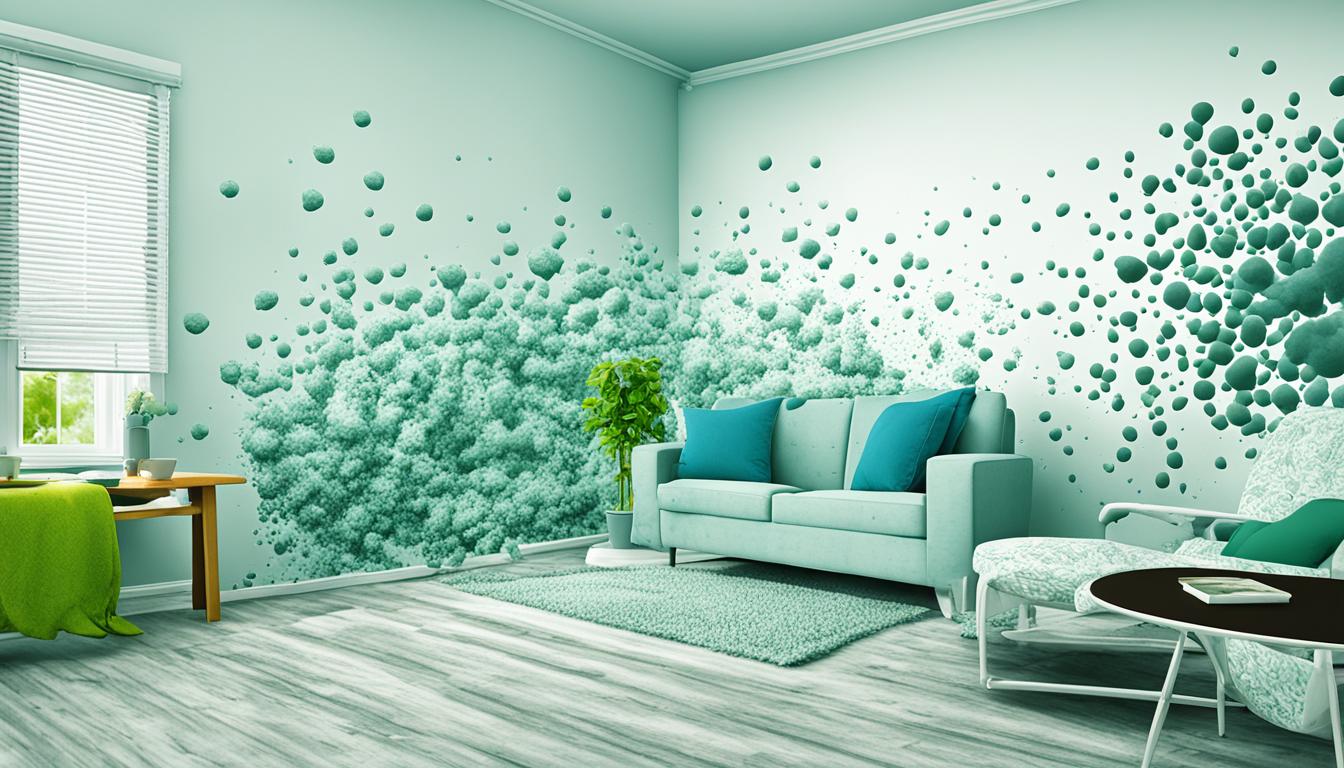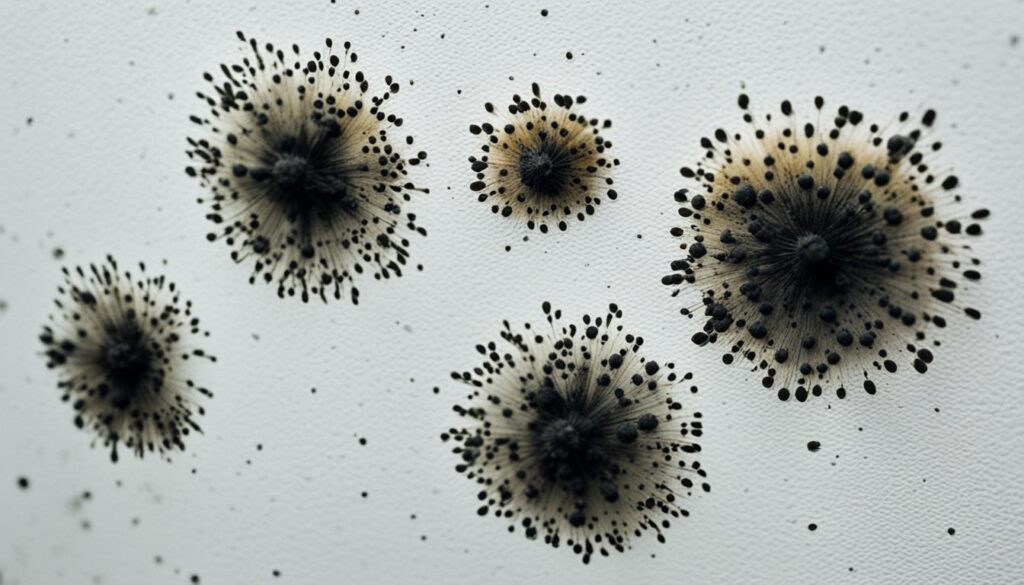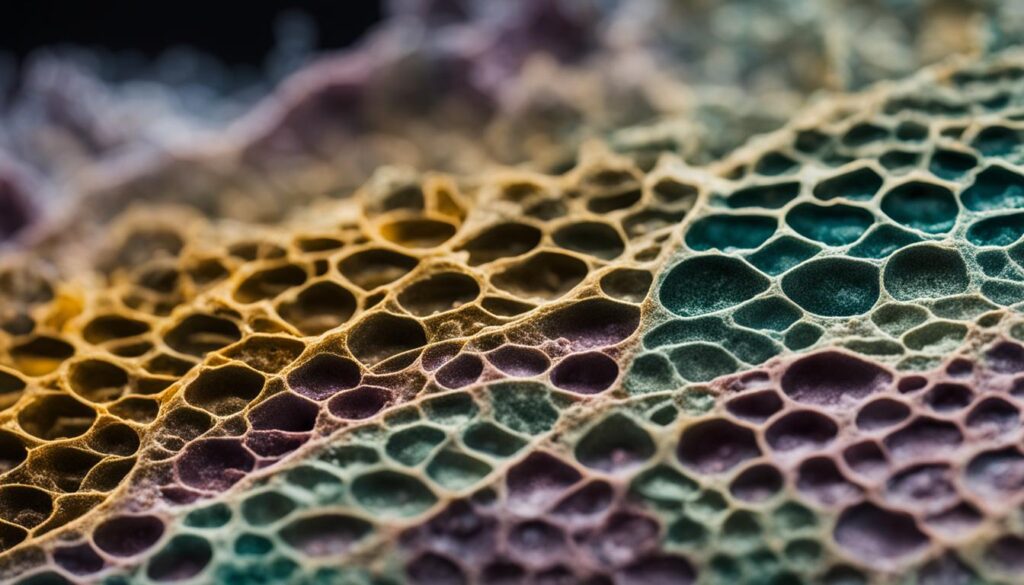
Is All Mold Dangerous? Unveiling the Myths
When it comes to mold, there are many misconceptions and fears surrounding its potential dangers. In this section, we will debunk these myths and shed light on the truth about mold toxicity. We will also explore the specific health effects of black mold, providing you with valuable insights to better understand the risks associated with different types of mold.
Key Takeaways:
- There are common misconceptions about the dangers of mold.
- Understanding the health effects of black mold is crucial.
- Not all mold is dangerous, but it’s essential to stay informed.
- Mold toxicity can have varying effects on individuals.
- Identifying harmful mold strains is important for addressing potential health risks.
Understanding Mold Toxicity and Health Effects
In this section, we will delve deeper into the concept of mold toxicity and its impact on human health. It is important to understand the health effects of mold exposure, especially when it comes to toxic molds such as black mold. By recognizing the symptoms associated with toxic mold exposure, you can take the necessary steps to protect yourself and your loved ones.

Mold toxicity refers to the harmful effects that can arise from exposure to certain types of mold. Black mold, also known as Stachybotrys chartarum, is a particularly concerning mold due to its potential health risks. When black mold releases spores into the air, these microscopic particles can be inhaled and trigger adverse reactions in susceptible individuals.
Exposure to black mold can lead to a range of health effects. The symptoms may vary depending on the individual’s sensitivity and the duration and intensity of exposure. Some common symptoms of toxic mold exposure include:
- Respiratory problems: Breathing difficulties, coughing, wheezing, and throat irritation may occur.
- Allergic reactions: Mold spores can trigger allergic reactions, causing hay fever-like symptoms such as sneezing, watery eyes, and nasal congestion.
- Skin irritation: Contact with black mold can cause skin rashes, itching, and inflammation.
- Headaches and dizziness: Some individuals may experience persistent headaches or dizziness as a result of mold exposure.
In severe cases, prolonged exposure to toxic mold can lead to more serious health complications. These may include respiratory infections, asthma exacerbation, and even lung damage in individuals with compromised immune systems or pre-existing respiratory conditions.
“It’s important to note that not everyone exposed to toxic mold will experience symptoms or have severe reactions. However, those who are hypersensitive or have underlying health issues may be at higher risk.”
If you suspect that you have been exposed to black mold or are experiencing symptoms related to mold toxicity, it is crucial to consult with a healthcare professional. They can evaluate your symptoms, conduct appropriate testing, and provide guidance on necessary interventions to minimize the potential health risks.
Minimizing Mold Exposure
To reduce the risk of mold-related health issues, it is essential to minimize exposure to mold and create a mold-free living environment. Here are some preventive measures to consider:
- Maintain proper ventilation and airflow in your home to prevent moisture buildup, which is conducive to mold growth.
- Fix any leaks or water damage promptly to prevent the growth of mold colonies.
- Control indoor humidity levels below 50% to discourage mold growth. Consider using dehumidifiers if necessary.
- Regularly inspect and clean areas prone to mold, such as bathrooms, basements, and kitchens.
- Ensure proper insulation and waterproofing in areas susceptible to moisture, such as roofs, windows, and foundations.
By implementing these preventive measures, you can help protect yourself and your family from the potential health effects of chronic mold exposure.
Identifying Harmful Mold Strains
In this section, we will provide expert insights on how to identify harmful mold strains. Recognizing the presence of toxic mold in your surroundings is crucial for your well-being and the health of your loved ones. Professional mold inspection and testing play a vital role in accurately determining the type of mold present and its potential risks.
The Importance of Professional Mold Inspection and Testing
When it comes to harmful mold identification, relying on professional mold inspection and testing services is highly recommended. These experts possess the knowledge, experience, and specialized equipment necessary to detect and analyze the presence of toxic mold accurately.
“Professional mold inspection and testing services are essential for accurate identification and assessment of harmful mold strains.”
During a mold inspection, professionals will conduct a comprehensive assessment of your property to identify conditions conducive to mold growth. They will also collect samples from various areas to determine the presence and types of mold present.

Recognizing Potentially Harmful Mold Situations
While professional inspection is crucial, it’s also essential to be aware of potential signs of harmful mold in your environment. Here are some common indications:
- Visible mold growth, such as black, green, or white patches on surfaces
- Musty or earthy odor in specific areas of your property
- Water damage, leaks, or excessive moisture in certain parts of your home or building
- Increased allergic reactions or respiratory issues among occupants
Common Harmful Mold Strains and Their Characteristics
| Mold Strain | Appearance | Common Health Effects |
|---|---|---|
| Stachybotrys chartarum (Black Mold) | Black or dark green patches, slimy texture | Respiratory issues, allergic reactions, neurological symptoms |
| Aspergillus | Green, yellow, or white patches, powdery or fuzzy texture | Allergic reactions, lung infections, respiratory inflammation |
| Penicillium | Blue, green, or white patches, velvety texture | Allergic reactions, respiratory issues, sinus infections |
| Cladosporium | Olive-green or brown patches, suede-like texture | Allergic reactions, skin rashes, respiratory problems |
It is important to note that identifying harmful mold strains based on appearance alone can be challenging. Professional mold testing provides accurate identification and assessment for appropriate remediation.
Prevention and Strategies for Indoor Mold Control
When it comes to dealing with mold, prevention is essential. By implementing effective strategies for indoor mold prevention, you can create a safe and healthy environment. Here are some practical tips to help you control mold growth and minimize the risk of mold-related health hazards:
- Control moisture: Mold thrives in damp environments, so it’s important to keep your indoor spaces dry. Fix any leaks in pipes, roofs, or windows promptly and regularly check for condensation.
- Improve ventilation: Good airflow helps prevent the accumulation of moisture. Use fans, open windows, and run exhaust fans in bathrooms and kitchens to enhance ventilation and reduce humidity.
- Maintain appropriate humidity levels: Mold grows best in environments with high humidity. Use dehumidifiers to keep indoor humidity levels below 50%, particularly in basements and other areas prone to dampness.
- Regularly clean and inspect: Regular cleaning helps remove mold spores and prevents their buildup. Pay attention to high-moisture areas like bathrooms, kitchens, and basements. Use mold-resistant cleaning products and regularly inspect hidden areas such as crawl spaces and attics for any signs of mold growth.
- Properly vent appliances: Ensure that appliances that produce moisture, such as dryers and stoves, are correctly vented outside. This prevents excess moisture from accumulating indoors.
- Use mold-resistant materials: When renovating or building, choose mold-resistant materials such as mold-resistant drywall and paints. These materials can help inhibit mold growth and make cleaning easier.
To effectively implement these strategies, it is crucial to understand the specific conditions in your home or business premises. Identifying potential problem areas and addressing them promptly is key to successful indoor mold prevention.
“Prevention is the most cost-effective approach to dealing with mold. By implementing simple measures to control moisture and improve ventilation, you can drastically reduce the risk of mold-related health issues.” – Dr. Samantha Johnson, Environmental Scientist
Importance of Regular Mold Inspections
While prevention plays a critical role, it’s essential to be proactive in assessing the presence of mold indoors. Regular mold inspections conducted by professionals can help identify mold growth in its early stages and prevent further damage. Additionally, professional mold inspections can provide valuable insights into the type of mold present and the potential health risks associated with it.
In the next section, we will discuss how to identify harmful mold strains and the significance of professional mold testing in ensuring accurate detection and assessment.
Mold Removal Services and Remediation
If mold is already present in your home or business, it’s crucial to take appropriate action. Ignoring the problem can lead to further damage and possible health risks. In this section, we will discuss the importance of professional mold removal services and remediation and guide you on how to choose the right mold remediation company.
The Importance of Professional Mold Removal Services
When it comes to mold removal, hiring professionals is essential. Mold spores are microscopic and can spread easily, making it difficult to completely eliminate mold on your own. Professional mold removal services have the expertise, equipment, and experience needed to effectively remove mold from your property.
By hiring experts, you can ensure that the mold problem is addressed thoroughly and safely. They will not only remove visible mold but also identify and eliminate hidden mold sources that are often the root cause. Professional mold removal services follow industry-standard protocols, ensuring a comprehensive and long-term solution.
Choosing the Right Mold Remediation Company
When selecting a mold remediation company, it’s crucial to consider certain factors to ensure you make an informed decision:
- Experience: Look for a company with extensive experience in mold removal and remediation. Experienced professionals are well-versed in identifying different types of mold and implementing effective strategies for removal.
- Certifications: Confirm that the mold remediation company holds relevant certifications, such as the IICRC (Institute of Inspection, Cleaning and Restoration Certification). These certifications demonstrate their commitment to quality and adherence to industry standards.
- References and Reviews: Read customer reviews and testimonials to gauge the reputation of the company. Additionally, ask for references and contact previous clients to gain insights into their experiences.
- Comprehensive Assessment: A reputable mold remediation company will conduct a thorough inspection of your property to assess the extent of the mold problem. This assessment will help them devise an appropriate and customized remediation plan.
- Clear Communication and Documentation: Choose a company that communicates clearly and provides detailed documentation throughout the process. This includes written estimates, progress reports, and a final report outlining the work performed.
By evaluating these factors and choosing a mold remediation company that meets your requirements, you can ensure that the mold removal process is executed efficiently and professionally.
Remember, mold removal is not a DIY project. Seeking professional help from reputable mold remediation companies is crucial for effective and safe mold removal. Taking prompt action can help protect your property and the health of yourself and your loved ones.
Conclusion
To conclude, it is important to dispel the common myth that all mold is dangerous. While certain types of mold, such as black mold, can pose health risks, not all molds are harmful. By understanding the facts about mold and taking proactive measures, you can create a healthy and mold-free environment for yourself and your loved ones.
Throughout this article, we have provided valuable information on identifying harmful mold strains, preventing mold growth, and seeking professional help for mold removal and remediation. It is crucial to recognize the potential health effects of toxic mold exposure, especially when it comes to black mold.
By implementing strategies for indoor mold control, such as controlling moisture levels and improving ventilation, you can significantly reduce the risk of mold-related health hazards. Additionally, if you already have mold present in your property, it is important to seek the expertise of professional mold removal services and remediation companies to effectively address the issue.
Remember, staying informed and taking necessary precautions are key to maintaining a safe and healthy environment. While not all mold is dangerous, it is essential to remain vigilant and prioritize mold prevention and control to ensure the well-being of yourself and your loved ones.




